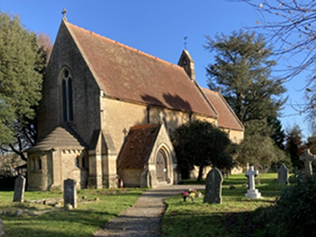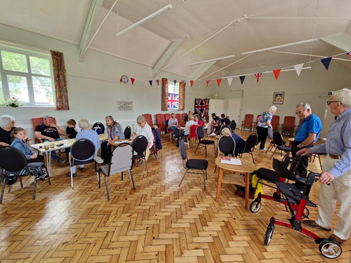St John’s Church, Boreham
In the Parish of Bishopstrow and Boreham
About Our Church
At St John’s Church our focus is inclusivity and social justice, both locally and globally.
All people of all ages are welcome in our Church. We have a toy box for any young children but please feel free to bring your child’s favourite toys along with them to our services. We also have a ramp facility that is placed at the entrance to the church before every service but it you think you may require further assistance accessing the church, then please do get in touch. Communion will also be brought to you should you not be able to access the altar.
Before all our services you will be greeted by a member of the congregation but if you arrive during a service, please help yourself to one of the hymn books at the entrance and take a seat wherever you wish.
We also support and work closely with the children and younger people of St John’s CofE Primary School and Kingdown Secondary School.


We support the Warminster Foodbank, Christian Aid, The Children’s Society and support various other charities. We welcome any volunteers and suggestions.
We have a monthly Coffee Morning held at our Parish Hall from 10.30am to 12.30. There are cakes for sale and a small raffle. All are very welcome for a hot drink and a chat. Keep an eye on our ‘What’s On’ section or our social media for confirmation of the exact dates.
Services
We also have morning prayer every Friday at 9am.
The Church is also open daily Monday to Friday for private prayer.
Find Us
Boreham Road, Warminster, Wiltshire, BA12 9JY
We do not have a car park, but you can park along Boreham Road which is a public road.
We also have a Facebook Page with up-to-date events and information. Please follow, like and share.
St John’s Church, Boreham
Boreham Road, Warminster, Wiltshire, BA12 9JX
Weddings
St John’s Church is a perfect setting for your wedding day. If you would like your wedding with us, please get in touch. We can then arrange a meeting with you and discuss your special day. You will need to complete some paperwork, but you will be guided through this process and any questions answered.
Baptisms
 Our Baptisms take place at the west end of the Church. The area was designed by architect Charles Ponting with London glaziers J Powell and Sons of Whitefriars providing the mosaic tile decoration around 1912. This beautiful area of the Church is perfect to celebrate this wonderful time with you and your family and friends.
Our Baptisms take place at the west end of the Church. The area was designed by architect Charles Ponting with London glaziers J Powell and Sons of Whitefriars providing the mosaic tile decoration around 1912. This beautiful area of the Church is perfect to celebrate this wonderful time with you and your family and friends.
If you would like to have a Baptism at St John’s Church, we will firstly arrange a visit with you to complete the details of the person to be Baptism and godparents. You will usually have a rehearsal prior to the day and on the day you will be greeted by the Reverend taking the service. Please let us know of any hymns, music or readings you like prior to the day.
Funerals
During this difficult time, St John’s Church will assist where we can with the preparation of any funeral service, and we will work closely with the funeral directors. If you would like to have the service at St John’s Church, please get in touch.
Burial Records
 Do you wish to search for the burial records for members of your family buried in St John’s churchyard? DVDs are now available. Each DVD contains a Microsoft Excel Workbook containing all the entries from the Burials Register from 1886 to May 2020 , and individual high quality photographs of each page of the Burials Register.
Do you wish to search for the burial records for members of your family buried in St John’s churchyard? DVDs are now available. Each DVD contains a Microsoft Excel Workbook containing all the entries from the Burials Register from 1886 to May 2020 , and individual high quality photographs of each page of the Burials Register.
£10 plus £1.50 postage.
Please contact the Parish Office if you would a copy of the Burial Records.
St John’s Parish Hall
Our Parish Hall is located between St John’s Primary School and The Hive on Boreham Road. With our recent renovation we hope you find the hall inviting for your events. It has a kitchen area and toilet facilities. If you would like further details about renting the hall and its availability, please email the hall manger Cathie Sale on salecathie74@gmail.com


St John’s Coffee Morning
St John’s Church have a monthly coffee morning where everyone is welcome. Please check the ‘What’s On’ Section for the confirmed dates.

The History of St John’s Church
Our Church Building is a small Victorian church and home to a number of renowned mosaics by Powell of Whitefriars. It is a listed Grade 2 Building. The church was built in a field called Picked Acre alongside Boreham Road. The eight acres of land was given for a church and churchyard, together with an endowment for its upkeep, by William Temple of Bishopstrow House in 1859. The Reverend JE Phillips, the vicar of Warminster, opened a building fund with £500 from Mr Temple and a sum of £2,700 was raised in less than a year, a figure more than the eventual cost of £1,935. The main building work was undertaken by a Mr Strong of Portway to a design by London architect George Edmund Street, who also designed the school in 1872 and the lychgate in 1874. St John’s Church was completed in 1865.
Mosaics
The mosaics at St John’s were made by James Powell and Sons of the Whitefriars Foundry, London between 1888 and 1915. Whitefriars produced hand made glass which was exported throughout Europe. James Powell’s grandson, Harry took over the factory after the death of his grandfather.
It was Harry who developed the mosaic side of the business. He was concerned about glass produced in his foundry, which had become contaminated. He discovered that tiny specks of clay from the crucibles in which the glass was melted, was causing this contamination. He experimented and found that this waste glass could be ground to a powder and baked. This would produce a solid material with an ‘eggshell’ surface, which could be used for mosaics. The range of colours was almost unlimited.


These mosaics are made in a style known as Opus Sectile, meaning ‘one piece’. Although some of the backgrounds are made with small, regular pieces of glass,, the figures are made of larger, irregular pieces. So an angel’s wing or a fold in a robe might be one piece of mosaic.
The areas of gold, in the nativity scene, for example, use a technique called ‘smalti’ in which pieces of gold foil are sandwiched between tiny pieces of glass.
The development of mosaics on biblical themes coincided with the Victorian era and the colourful and detailed pictures had great appeal. Wealthy Victorians liked to donate a mosaic either as a memorial or simply as a present to their local church and ancient churches, therefore, often have a mosaic, usually a reredos, made by Powell, installed in the Victorian era. Churches actually built in the Victorian age, like ours, would be more likely to have a collection of panels around the walls donated by enthusiastic patrons.




